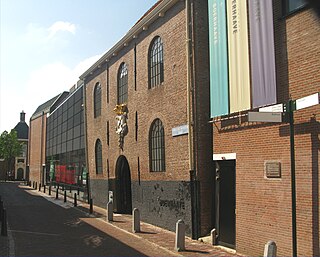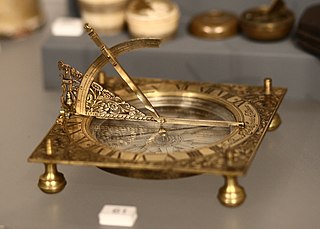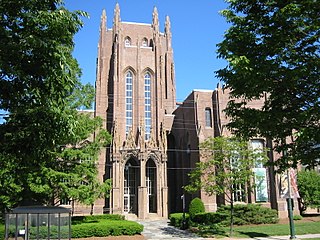
A museum is a building or institution that cares for and displays a collection of artifacts and other objects of artistic, cultural, historical, or scientific importance. Many public museums make these items available for public viewing through exhibits that may be permanent or temporary. The largest museums are located in major cities throughout the world, while thousands of local museums exist in smaller cities, towns, and rural areas. Museums have varying aims, ranging from the conservation and documentation of their collection, serving researchers and specialists to catering to the general public. The goal of serving researchers is not only scientific, but intended to serve the general public.
A scientific instrument is a device or tool used for scientific purposes, including the study of both natural phenomena and theoretical research.

The Oregon Museum of Science and Industry is a science and technology museum in Portland, Oregon, United States. It contains three auditoriums, including a large-screen theatre, planetarium, and exhibition halls with a variety of hands-on permanent exhibits focused on natural sciences, industry, and technology. Transient exhibits span a wider range of disciplines.

The Rosicrucian Egyptian Museum (REM) is devoted to ancient Egypt, located at Rosicrucian Park in the Rose Garden neighborhood of San Jose, California, United States.

Teylers Museum is an art, natural history, and science museum in Haarlem, Netherlands. Established in 1778, Teylers Museum was founded as a centre for contemporary art and science. The historic centre of the museum is the neoclassical Oval Room (1784), which was built behind the house of Pieter Teyler van der Hulst (1702–1778), the so-called Fundatiehuis. Pieter Teyler was a wealthy cloth merchant and banker of Scottish descent, who bequeathed his fortune for the advancement of religion, art, and science. He was a Mennonite and follower of the Scottish Enlightenment.

The Bradbury Science Museum is the chief public facility of Los Alamos National Laboratory, located at 1350 Central Avenue in Los Alamos, New Mexico, in the United States. It was founded in 1953, and was named for the Laboratory's second director (1945-1970), Norris E. Bradbury. Among the museum's early exhibits, artifacts and documents from World War II Manhattan Project were displayed upon declassification. Other exhibits include full-size models of the Little Boy and Fat Man atomic bombs. Admission is free.

The History of Science Museum in Broad Street, Oxford, England, holds a leading collection of scientific instruments from Middle Ages to the 19th century. The museum building is also known as the Old Ashmolean Building to distinguish it from the newer Ashmolean Museum building completed in 1894. The museum was built in 1683, and it is the world's oldest surviving purpose-built museum.

Rijksmuseum Boerhaave is a museum of the history of science and medicine, based in Leiden, Netherlands. The museum hosts a collection of historical scientific instruments from all disciplines, but mainly from medicine, physics, and astronomy.
The Canadian Conservation Institute is a special operating agency of the federal Department of Canadian Heritage that provides research, information, and services regarding the conservation and preservation of cultural artifacts.

Museo Galileo, the former Istituto e Museo di Storia della Scienza is located in Florence, Italy, in Piazza dei Giudici, along the River Arno and close to the Uffizi Gallery. The museum, dedicated to astronomer and scientist Galileo Galilei, is housed in Palazzo Castellani, an 11th-century building which was then known as the Castello d’Altafronte.

Butler's Barracks was the home of Loyalist military officer John Butler (1728–1796), in what was then Newark, Upper Canada; present day Niagara-on-the-Lake, Ontario. Butler is most famous for leading an irregular military unit known as Butler's Rangers on the northern frontier during the American Revolutionary War.
The Niagara Falls Museum was founded by Thomas Barnett, an Englishman from Birmingham in 1827. It is best known as the oldest Canadian museum and for having housed the mummy of Ramesses I for 140 years before its return to Egypt in 2003. The building has undergone several vocational changes and building refurbishments in its history.

The Dittrick Museum of Medical History is part of the Dittrick Medical History Center of the College of Arts and Sciences of Case Western Reserve University, Cleveland, Ohio. The Dittrick Medical History Center is dedicated to the study of the history of medicine through a collection of rare books, museum artifacts, archives, and images. The museum was established in 1898 by the Cleveland Medical Library Association and today functions as an interdisciplinary study center. It is housed in the Allen Memorial Medical Library on the campus of Case Western Reserve University in Cleveland, Ohio's University Circle.

The Canada Science and Technology Museum is located in Ottawa, Ontario, Canada, on St. Laurent Boulevard, to the south of the Queensway. The role of the museum is to help the public to understand the technological and scientific history of Canada and the ongoing relationships between science, technology and Canadian society. The Canada Science and Technology Museum is operated by Ingenium which also runs the Canada Agriculture and Food Museum and the Canada Aviation and Space Museum.

The Science History Institute is an institution that preserves and promotes understanding of the history of science. Located in Philadelphia, Pennsylvania, it includes a library, museum, archive, research center and conference center.
Physics outreach encompasses facets of science outreach and physics education, and a variety of activities by schools, research institutes, universities, clubs and institutions such as science museums aimed at broadening the audience for and awareness and understanding of physics. While the general public may sometimes be the focus of such activities, physics outreach often centers on developing and providing resources and making presentations to students, educators in other disciplines, and in some cases researchers within different areas of physics.
The Peoria Riverfront Museum is a public museum of art, science, history, and technology located on the riverfront in downtown Peoria, Illinois. Containing a planetarium, a giant screen theater, exhibits, a 15,000-object collection, educational classes, and public outreach, it opened in October 2012 as a successor to Peoria's Lakeview Museum of Arts & Sciences, established in 1965.

Harvard University's Collection of Historical Scientific Instruments (CHSI), established 1948, is "one of the three largest university collections of its kind in the world". Waywiser, the online catalog of the collection, lists over 60% of the collection's 20,000 objects as of 2014. The collection was originally curated by Mr. David P Wheatland in his office to prevent obsolete equipment from being cannibalized for its component parts and materials.

The Peabody Museum of Natural History at Yale University is among the oldest, largest, and most prolific university natural history museums in the world. It was founded by the philanthropist George Peabody in 1866 at the behest of his nephew Othniel Charles Marsh, the early paleontologist. Most known to the public for its Great Hall of Dinosaurs, which includes a mounted juvenile Brontosaurus and the 110-foot-long (34 m) mural The Age of Reptiles, it also has permanent exhibits dedicated to human and mammal evolution; wildlife dioramas; Egyptian artifacts; and the birds, minerals and Native Americans of Connecticut.
Science tourism is a travel topic grouping scientific attractions. It covers interests in visiting and exploring scientific landmarks, including museums, laboratories, observatories and universities. It also includes visits to see events of scientific interest, such as solar eclipses.















